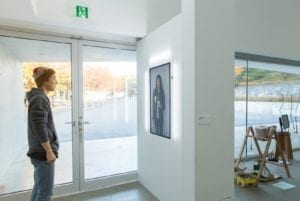“ Interaction: a cyclic process in which two actors alternately listen, think, and speak” (5). —— Crawford used this concrete example to define interaction. To explain it in a more academic way, we can replace listen, think, and speak with input, process, and output. I do agree with this inspiring analogy, but I still consider it as a bit vague. From my point of view, interaction should be separated into two parts: physical interaction and emotional interaction. Physical interaction is clear and manifest in the structure of a design, while emotional interaction involves emotions, humanistic feelings and aesthetic value. High-level interactivity should combine those two aspects organically. In most cases, low-level interactivity only focus on the former.
To interpret my understanding of “interaction”, I want to use the two projects that I researched as examples.
The first project is named as OpenDataCam 2.0. It consists of a camera attached to a mini computer that is running an object detection algorithm that counts and tracks moving objects. On the software sideOpenDataCam is running YOLO, which is trained to detect objects in images (Filip Visnjic). The aim of this project is to quantify the world. There does exist interactivity, since the attached camera inputs data to YOLO and YOLO outputs all objects in each frame. However, it is not really convincing that OpenDataCamis a highly interactive project, which is probably because of the reason that there are scarcely any emotions, humanistic feelings or aesthetic pleasure. The interaction here is “cold” and “pale”.

The second project I want to mention aligns to my definition better, which is called “Sharing Faces”. It used a megapixel surveillance camera and custom software to match the face locations of the person looking at the screen. As the person moves, new images are pulled from the database matching the new location and create a mirror-like image of the user using the images of others (Filip Visnjic). Kyle McDonald, the project designer, said that the project was inspired by a story from the history of Rome. Two tribes went into war with each other and finally realized that they were all literally brothers. Moments of reflection on the nature of our connectedness made Kyle moved, and the project was thus created. The interaction here is not only about digital cameras, software, programming and machine building, but also focus on the interaction in the experiencers’ emotions. These two aspects of interaction interweave with each other, creating a touching and technologically advanced project.

The project of our group is named as “Paint Your Day”, in which we designed a system that keeps collecting body data’s from the user and will create a painting when the day ends. At the beginning of our first group meeting, we were all at a loss since we did not know where to start. Then, we decided to share our personal definition of “interaction” and discuss the focus of our project. We all agreed that we should involve the element of “emotion” and make our project more artistic. The original conception was to create a painting by voice pitch, but it was turned down later since it is hard to be practiced. The final plan was like this: the user starts his/her normal day, wearing a smartwatch; the smartwatch keeps inputting the user’s body data to the computer; the computer then analyzes and processes the data; the output will be a beautiful painting depicting the user’s day based on the processed data. This process shows the physical interaction of our project clearly. In addition, the user’s emotions during the day could be detected by the computer through the body data and be directly revealed in colors, shapes and lines, providing a new approach of recording one’s day. Painting is part of art, and art itself is emotional. Our project also shows humanistic feelings and brings aesthetic pleasure to our users. We successfully combined the physical and emotional interaction together, which aligned with my definition of “interaction” well.
References:
Crawford, “What Exactly is Interactivity,” The Art of Interactive Design, pp. 1-5.
OpenDataCam: https://www.creativeapplications.net/environment/opendatacam-2-0-an-open-source-tool-to-quantify-the-world/
Sharing Faces: https://www.creativeapplications.net/openframeworks/sharing-faces-seeing-yourself-reflected-in-the-image-of-others/